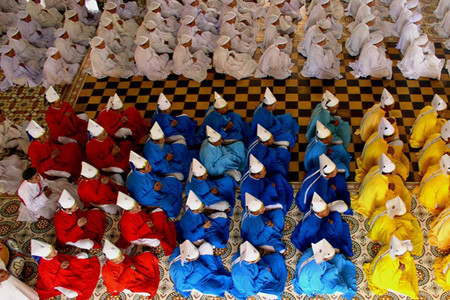This is the original sect of Caodaism under the full name Tay Ninh Caodaist Holy See (Cao Dai Toa thanh Tay Ninh). Since it is the original branch, the history of Caodaism is closely related to it...
Tay Ninh Caodaism
This is the original sect of Caodaism under the full name Tay Ninh Caodaist Holy See (Cao Dai Toa thanh Tay Ninh). Since it is the original branch, the history of Caodaism is closely related to it.
In the early 1930s, since there were disagreements and conflicts amongst Caodaist dignitaries, most of them left for the establishment of new sects. Particularly in 1934, two high- ranking dignitaries, Dau su Nguyen Ngoc Tuong and Dau su Le Ba Trang, left Tay Ninh Caodaism for Ben Tre where they implemented the Program for Religious Reform. This led to the establishment of Ban Chinh Dao Caodaism later, which officially marked the split in Caodaism's organizational structure.
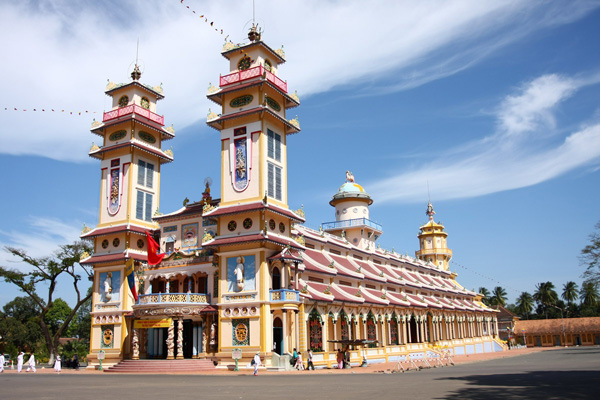
In this situation, Tay Ninh Caodaism focused on consolidating the organizational structure by introducing the Eight-religion Decree (Bat Dao Nghi dinh). Later, in the 1940s and 1950s, Tay Ninh Caodaism used Caodaism's army force to promote its missionary work and force Caodaist followers from other sects to follow it. Thanks to this, the number of Caodaist followers increased rapidly. In 1934, only 43 out of 128 Caodaist parishes followed Tay Ninh Caodaism. By 1945, the number of Caodaist followers had reached approximately one million, including thousands of dignitaries and sub-dignitaries throughout the South.
As the original sect of Caodaism, Tay Ninh Caodaism has always preserved the tenets, rules and rituals of Caodaism. For the political motivation, its organizational structure was consolidated as a state apparatus. Its establishments were more political and social than religious. The construction of Tay Ninh Holy See started in 1927 and finished in 1953. Its architecture was strongly influenced by the Vatican. It is one square km in area with forty-six religious, economic, cultural and social facilities. In 1965, the Sai Gon administration passed Decree 03/65 officially recognizing the legal status and Charter of Tay
Ninh Caodaism. Together with the recognized legal status and favourable conditions given by the Sai Gon administration, Tay Ninh Caodaism took advantage of the conditions of the fierce war to expand its influence. By 1975, the number of Caodaist followers had reach, nearly two million, including more than 10,000 dignitaries and sub-dignitaries.
After the liberation of the South in 1975, Tay Ninh Caodaism gradually turned solely to religious activities, resulting in the disappearance of its political and social organizations and the simplification of its administrative organizations. From the early 1980s up to the present day, Tay Ninh Caodaism has been under the management of the Council of Management, which includes its leaders. On May 9,1997, the Vietnam Government Committee for Religious Affairs adopted Decision No. 10/QD- TGCP officially recognizing the legal status and Charter of Tay Ninh Caodaism. In 2005, it had 1,509,444 followers, 2,176 dignitaries, 352 holy temples and 167 shrines dedicated to Bodhisattvas in 34 provinces and cities.
Ban Chinh Dao Caodaism
Ban Chinh Dao (Religious Reform Board) Caodaism is the second largest sect of Caodaism, only after Tay Ninh Caodaism. It was founded in the mid 1930s. Specifically, in 1934, due to conflicts with some other high-ranking dignitaries of Caodaism, Dau su Nguyen Ngoc Tuong and Dau su Le Ba Trang left Tay Ninh Caodaism. They returned to Ben Tre and designed the Program for Religious Reform. After many efforts to reunite with Tay Ninh Caodaism failed, Nguyen Ngoc Tuong, as the Pope, founded a new Caodaist sect called the Great Religion for the Third Period of Universal Salvation (Dai dao Tam ky Pho do), which was later renamed Ban Chinh Dao Caodaism.
In 1966, Ban Chinh Dao Caodaism was plugged into conflict due to a disagreement between the progressive dignitaries and conservative ones who considered themselves the so-called the Holy Canon Protection Board (Ban Bao ve Thanh giao). Finally, the progressive dignitaries led by Tran Chi Thanh left Ben Tre Great Temple for Do Thanh Temple in Sai Gon. There, they set up a liaison office and then established two sub-sects of Ban Chinh Dao Caodaism, namely Ben Tre Ban Chinh Dao Caodaism and Do Thanh Ban Chinh Dao Caodaism. On August 8, 1997, the Head of the Vietnam Government Committee for Religious Affairs issued Decission No. 26/QD-TGCP officially recognizing the Charter and legal status of Ban Chinh Dao Caodaism on the basis of having its two sub-sects revert to the original state.
Basically, the tenets, rules and rituals of Ban Chinh Dao Caodaism were similar to those of Tay Ninh Caodaism. However, it formulated the Three-level Religious Practice (Phuong tu tam thua) including the low level (Ha thua), intermediate level (Trung thua) and high level (Thuong thua). At the same time, it created its own law called the New Law (Tan luat), including the General Amnesty (Dai xa), the Removal of Sufferings (Giai kho) and the Pure Practice (Tinh luyen). Particularly, it does not use . All the aforementioned characteristics help to differentiate it from the other sects of Caodaism.
Early after its foundation, Ban Chinh Dao Caodaism had a large number of followers, which roughly equalled to two-thirds of Caodaist followers and dignitaries. Later, however, many of them went back to Tay Ninh Caodaism. Moreover, from the 1960s onwards, Ban Chinh Dao Caodaism was plunged into internal conflicts, which hindered its attempts to attract more followers. In 2005, it had 788,592 followers, 2,977 dignitaries, 249 holy temples and 8 shrines dedicated to Bodhisattva in 24 provinces and cities, mainly in the South.
Tien Thien Caodaism
After its official establishment in Tay Ninh in 1926, Caodaism expanded its missionary work in the provinces of the Mekong River Delta. Among its dignitaries in this area, Dau su Le Van Lich and Giao huu Nguyen Huu Chinh were punished disciplinarily for having abused Co but and plotted to establish their own sect. In 1930, after being expelled from Tay Ninh Caodaism, Nguyen Huu Chinh left for My Tho. With the support from Le Van Lich and Minh Su's Co but groups, he founded a new sect of Caodaism called Tien Thien Great Religion for the Third Period of Universal Salvation (Tien Thien Dai dao Tam ky Pho do), also known as Tien Thien Caodaism.
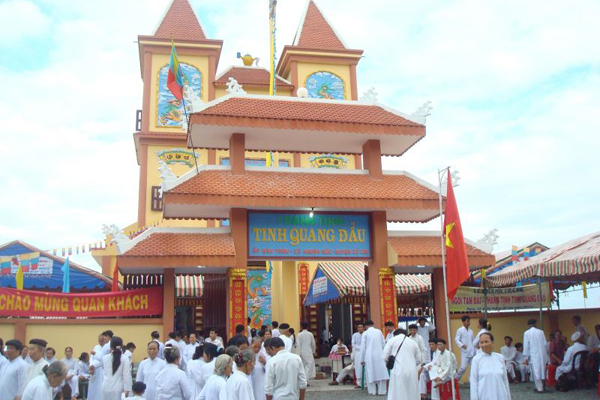
Tien Thien Caodaism cleverly exploited Co but in the remote rural areas. This, together with the support from Minh Su's dignitaries in Ngu Chi Minh Dao and the assistance from Phan Van Tong and Le Kim Ty, helped it to expand its influence. Four years after its establishment, it had 72 holy temples and tens of thousands of followers with Thien Thai Holy Temple as its center. After the August Revolution in 1945, it became the core of the organization called the National Salvation Caodaism (Cao Dai Cuu quoc) and the Only Holy Society of the Great Religion for the Third Period of Universal Salvation (Hoi thanh Duy nhat Dai dao Tam ky Phodo), so it stopped its activities organizationally.
In 1955, Tien Thien Caodaism was re-established. In 1963, it was plunged into internal conflicts. Consequently, some dignitaries left Chau Minh for Minh Duc Holy Temple (My Tho) and established a new church called Tien Thien Minh Duc. Accordingly, Tien Thien Caodaism was split into two sub-sects: Chau Minh Tien Thien Caodaism and Minh Duc Tien Thien Caodaism. They existed until 1975.The doctrine of Tien Thien Caodaism was based on the Three Religions Gathered Together (Quy tam giao) and the Five Branches United (Hiep ngu chi). Nevertheless, since it was directly influenced by Ngu Chi Minh Dao, its rituals and religious practices are close to those of Ngu Chi Minh Dao. Accordingly, it took pure practice as the focus of religious practice and maintained Co but. From its establishment to 1975, it made full use of Co but, not only in religious activities but also in dealing with organizational issues and social relations related.
On July 29, 1995, the Head of the Vietnam Government Committee for Religious Affairs promulgated the Decission No. 51/QD-TGCP officially recognizing the legal status of Tien Thien Caodaism on the basis of uniting its two sub - sects. In 2005, this sect had approximately 40,000 followers, 1,650 dignitaries, 126 holy temples and 6 shrines dedicated to Bodhisattva in 12 provinces and cities, mainly in the Mekong River Delta.
Chon Ly Caodaism
Chon Ly Caodaism is also known as Minh Chon Ly Caodaism. It was the first sect to split from Tay Ninh Caodaism. Nguyen Van Ca, the founder of Chon Ly Caodaism, used to be a Phoi su of Tay Ninh Caodaism. In 1930, Nguyen Van Ca, who was described as serious and honest, expressed discontent with the way some of the high-ranking dignitaries managed Tay Ninh Caodaism. As a result, he left Tay Ninh for My Tho with the aim of practicing the faith and exposing the truth of Tay Ninh Caodaism. At first, he did not plan to cause dissension.
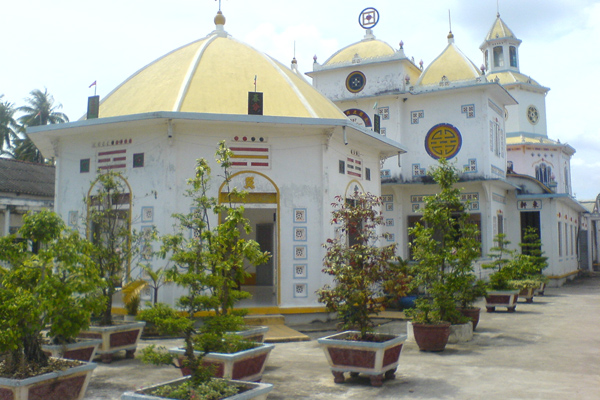
However, after Tay Ninh Caodaism continuously issued decisions to dismiss him as a Phoi su, he decided not to come back to Tay Ninh. Instead, he and some other dignitaries founded a Caodaist sect called Minh Ly Hoi Caodaism, which was renamed Minh Chon Ly Caodaism in 1932. In 1971, it was officially recognized by the Sai Gon administration under a new name: Chon Ly Dinh Tuong Holy Society. On March 14, 2000, the Head of the Vietnam Government Committee for Religious Affairs adopted the Decission No. 16/2000/QD-TGCP approving the Charter and legal status of Chon Ly Caodaism.
Instead of worshipping the Divine Eye by tradition, Chon Ly Caodaism worshipped the Eye in Heart, which is the symbol of God. It also does not follow Phap Chanh truyen or Tan luat. It does not use such prayer books as Kinh cung tu thoi or Kinh quan hon tang te as Tay Ninh Caodaism does. Particularly, it created a new organizational structure that excludes Giao tong and Ho phap (Head of the Legislative Affairs). The new structure, called Thap ngu linh dang, includes the following ranks: Chuong quan (two positions), Dau su (three positions), Tu buu (four positions) and Thien su (five positions). They are responsible for the internal and external affairs, rituals and missionary work of the sect. Below them are ranks from Le sanh to Phoi su, who are in charge of religious activities in temples.
At its establishment in 1932, Chon Ly Caodaism had more than 10,000 followers and 11 holy temples. By 1938, the number of its followers had increased to nearly 50,000. Then for some reasons, this number did not increase. In 2005, it had 6,577 followers, including 1,786 dignitaries, and 28 places of worship, including 27 holy temples and 1 shrine dedicated to Bodhisattva in 11 cities and provinces.
Minh Chon Caodaism
Minh Chon Caodaism originated from Chon Ly Caodaism. During 1931-1932, Cao Dai Chon Ly led by Nguyen Van Ca developed strongly and drew many high-ranking dignitaries from Tay Ninh Caodaism, including Chuong phap (Legislative Cardinal) Tran Dao Quang. However, after finding differences in the religion-practicing content of Chon Ly Caodaism, dignitaries Tran Dao Quang and Phan Van Thieu left for Bac Lieu. Here, they together with Cao Trieu Phat, Huynh Ngoc Ton and Nguyen Hien Ngo practiced the religion independently. In 1934, they declared the official establishment of a new Caodaist sect called Hau Giang Minh Chon Caodaism or Minh Chon Caodaism.
Initially, the sect was led by Chuong phap Tran Dao Quang, who took charge of Cuu Trung Dai, and Chuong phap Cao Trieu Phat, who took charge of Hiep Thien Dai. In 1947, it joined the National Salvation Caodaism and the Only Holy Society of the Great Religion for the Third Period of Universal Salvation and became their core under the leadership Chuong phap Cao Trieu Phat. In 1954, after Chuong phap Cao Trieu Phat went to Hanoi to become Giao tong of the Only Holy Society of the Great Religion for the Third Period of Universal Salvation, Minh Chon Caodaism was re-established.
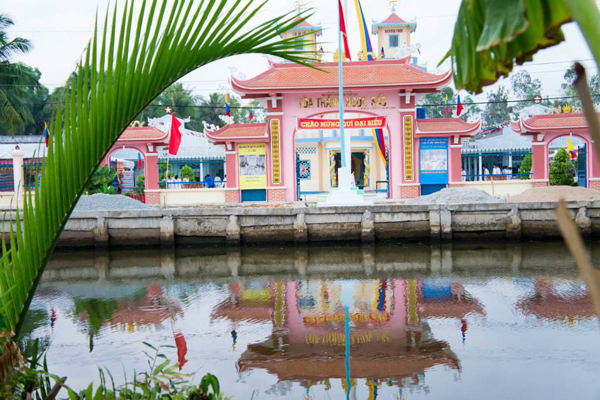
The tenets, rites and rituals of Minh Chon Caodaism are similar to those of other Caodaist sects. Although it was headed by Tran Dao Quang, one of the founders of Minh Su in Vietnam, its activities did not involve either Co but or Pure Practice. Minh Chon Caodaism is the combination of Tran Dao Quang's morality of true believers to save from misfortune and danger and Cao Trieu Phat's spirit of social progress. This combination is reflected in the sect's motto, "Relying on religions to save and protect living things," paying attention to both religious and social activities.
On August 2, 1996, the Head of the Vietnam Government Committee for Religious Affairs promulgated the Decision No. 39/QD-TGCP approving the Charter and legal status of Cao Dai Minh Chon. In 2005, it had 30,000 followers, including 609 dignitaries, and 49 holy temples in 4 provinces and cities.
Caodaist Missionary Holy Society
Early after its birth, Tay Ninh Caodaism conducted its missionary activities in the Central region of Vietnam. However, these activities were not successful as the Nguyen Dynasty had put a ban on the growth of Caodaism. In the late 1930s, despite the Nguyen Dynasty's prohibition, Cao Dai Tien Thien established 9 temples with nearly 10,000 followers. In late 1938, the Acting Caodaist Holy Society of Central Vietnam (Quyen Hoi thanh Trung Ky) was founded in Da Nang.
After the August Revolution in 1945, the Acting Caodaist Holy Society of Central Vietnam cooperated with Ban Chinh Dao Caodaism in the North to establish the Agency for Caodaist
Mission in North and Central Vietnam). During the anti-French resistance war, Caodaist missionaries faced lots of difficulties in travel. As a result, in early 1948, all the Caodaist parishes in Central Vietnam met in Quang Nam and decided to simplify its organization by establishing the Agency for Caodaist Mission in Central Vietnam. In 1956, on the occasion of the inauguration of Trung Hung Buu Temple in Da Nang, the Agency for Caodaist Mission in Central Vietnam was changed into the Caodaist Missionary Holy Society under the leadership of Phoi su Tran Van Que.
On September 24,1996, the Head of the Vietnam Government Committee for Religious Affairs issued Decision No. 40/QD- TGCP approving its Religious Regulations and legal status.
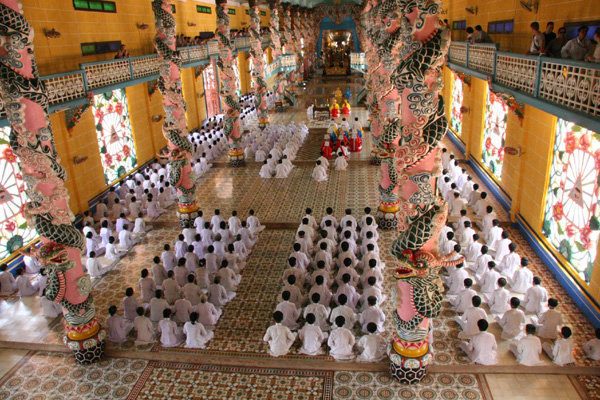
The tenets, rites and rituals of the Caodaist Missionary Holy Society are similar to those of other Caodaist sects. It is also based on the spirit of the Three Religions Gathered Together and the Five Sects United, and follows Thanh ngon hop tuyen, Phap Chanh truyen and Tan luat. Particularly, it originated from a missionary organization, so its organizational structure is much simpler that of any other Caodaist sect. Hiep Thien Dai was merged with Cuu Trung Dai to form four offices: Hanh Chinh (in charge of administrative work), Pho Te (in charge of religious practice), Phuoc Thien (in charge of charitable activities) and Minh Tra. For Caodaist parishes at the grassroots level, besides the central temples, each commune has a place of worship which functions as a chapel.
Besides their religious activities, the Caodaist Missionary Holy Society actively participated in the campaigns for the unification of Caodaism. They included the campaigns for the establishment of the Caodaist Union of Great Religion (Cao Dai Dai dao Lien doan) in 1936, the General Association of Caodaism (Lien hoa Tong hoi) in 1937, the Only Holy Society of the Great Religion for the Third Period of Universal Salvation in 1951 and the United Caodaism (Cao Dai Thong nhat) in 1952.
During 1940-1950, the number of its followers increased quickly. Then, it came to a standstill and remained unchanged until the liberation of the South. In 2005, it had 45,000 followers, including 554 dignitaries, 60 temples and 30 shrines dedicated to Bodhisattva in 12 provinces and cities, mainly in Central Vietnam.
Bach Y Caodaism
Bach Y Caodaism was separated from Chon Ly Caodaism in 1935 when its leaders had found differences in the religious practice of this Caodaist sect that were against Phap Chanh truyen and Tan luat. In 1936, Bach Y Caodaism was officially inaugurated in Mong Tho Temple with the participation of many dignitaries from many other sects including Tien Thien Caodaism, Ban Chinh Dao Caodaism, Minh Chon Caodaism and some others. Since then, Mong Tho Temple has been known as the To Dinh Holy See of Bach Y Caodaism.
The tenets, rites and rituals of Bach Y Caodaism are similar to those of many other Caodaist sects. However, it highlights the unity of religions, and its religious activities are influenced by the Noble Eightfold Path in Buddhism. Followers and dignitaries of Bach Y Caodaism are dressed in white as its name explains (Bach Y).
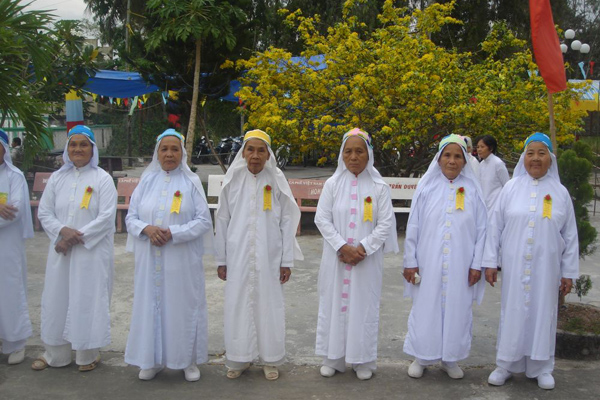
On July 8,1998, the Chairman of Kien Giang Province People's Committee issued Decision No. 60/QD-TGCP approving the Charter and legal status of Cao Dai Bach y. In 2005, it had 4,100 followers, including 88 dignitaries, 14 temples and 3 shrines dedicated to Bodhisattva in 2 provinces and cities.
Cau Kho Caodaism and cau Kho Tam Quan Caodaism
When Caodaism fell into internal division, most of its dignitaries who disagreed with the leaders of Tay Ninh Caodaism went to the Cau Kho Temple for shelter. (Cau Kho Temple is the first base of Caodaism in Sai Gon. It used to be the residence of Doan Van Ban, a provincial education officer under French domination. It is near the Cau Kho Primary School, so it was given that name.) Some of them stayed there for a period of time before moving to other places to establish new Caodaist sects while the others spent the rest of their lives there. Since then, Cau Kho has been known as an independent sect of Caodaism, not only a temple. In 1937 the Cau Kho Temple was re-constructed. Later, the French occupied it and turned it into the residence of their civil servants. In 1945, the Cau Kho Temple was built in another place which is now on Nguyen Cu Trinh Road, District 1, Ho Chi Minh City, under a new name, Nam Thanh Temple.
In the late 1920s and early 1930s, some migrants from Central Vietnam went to Sai Gon and practiced Caodaism in the Cau Kho Temple. When they returned to their hometowns, they established Caodaist groups in Binh Dinh, Quang Ngai and Phu Yen. This led to the establishment of a new Caodaist sect called Cau Kho Caodaism - Tam Quan Central Vietnam Church or Cau Kho Tam Quan Caodaism in 1937. Initially, it was simply organized under the leadership of a management board instead of two executive bodies, Cuu Trung Dai and Hiep Thien Dai.
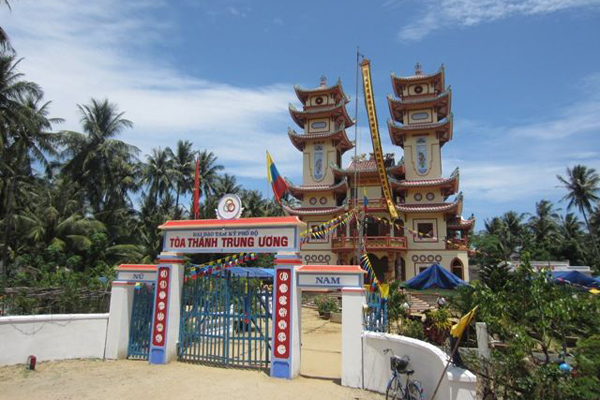
Then, in I960, when high-ranking dignitaries reached a great number, it reorganized its structure on the basis of Phap Chanh truyen and Tan luat. At the same time, it inaugurated its original temple in Tam Quan, Binh Dinh. In mid I960, due to the violent war, it had to evacuate and set up its representative offices in Quy Nhon, Nha Trang and Sai Gon to keep contact among its followers and dignitaries. On April 28, 2000, the Head of the Vietnam Government Committee for Religious Affairs issued Decision No. 199/2000/ QD-TGCP approving its Charter and legal status. In 2005, it had 9,000 followers, including 231 dignitaries, 28 temples and 1 shrine dedicated to Bodhisattva in 8 provinces and cities.
Chieu Minh Caodaism and Chieu Minh Long Chau Caodaism
Chieu Minh Caodaism was a Caodaist sect founded by Nguyen Minh Chieu, even before the official inauguration of Caodaism. Indeed, after splitting himself from Caodaism due to his concern over its political motivation, Nguyen Minh Chieu chose a site for religious practice in Hung Loi. Later, he developed it into a Caodaist temple and established a Caodaist sect named Chieu Minh Caodaism.
This sect does not pay much attention to the dissemination of tenets, but it focus on religious practice and the escape from the secular life with strict regulations called Tu tuyen do (performing salvation on chosen followers). By 1954, it had attracted thousands of followers and established 18 bases called dan, mainly in Can Tho.
In 1956, some of its members who had joined the National Salvation Caodaism and "Lien Giao I" (1955) and advocated Tu pho do (taking holy orders for universal salvation) established Chieu Minh Long Chau Caodaism and chose Chieu Minh Temple in Chau Thanh District, Can Tho Province, as its original temple. In terms of organization, it is based on the law Ngoc de chan truyen with two executive bodies, Cuu Trung Dai and Hiep Thien Dai, but it is simpler than the other Caodaist sects. It originated from Cao Dai Chieu Minh, so it still remains on good terms with Chieu Minh Caodaism, like Cau Kho Tam Quan Caodaism and Cau Kho Caodaism.
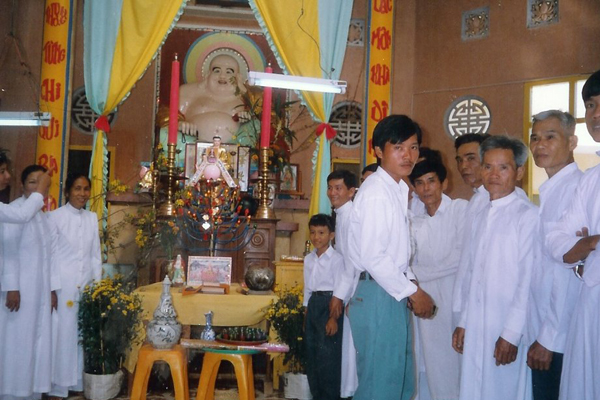
On July 27,1996, the Chairman of Can Tho Province People's Committee issued Decision No. 1562/QD.CT.HC.96 approving the Charter and legal status of Cao Dai Chieu Minh Long Chau. In 2005, it had 5,000 followers, including 88 dignitaries, 17 temples and 6 shrines dedicated to Bodhisattva in 6 provinces and cities.
Besides the aforementioned sects, before 1975, Caodaism also had many other sects such as Nguyen Nguyen Ban Ban Caodaism in Tan An, which was separated from Chon Ly Caodaism, Thong Thien Dai Caodaism in Go Cong, Tinh Coc Caodaism in Tay Ninh, Lam Huyen Chau Caodaism in Bac Lieu, Thuong De(God) Caodaism in Can Tho, Ben Tranh Vietnamese Caodaism in My Tho, Binh Duc Vietnamese Caodaism in My Tho and others.
Movements for Unity
Shortly after its establishment, Caodaism was plunged into internal division. This situation was immediately followed by movements for the unity of Caodaism.
The earliest movement broke out in 1936 and was initated by Tran Van Que from Cao Dai Tien Thien and some other dignitaries from the Cau Kho Temple (Sai Gon). This resulted in the establishment of an organization named the Caodaist Union of Great Religion. Due to its disagreement with the leaders of Caodaism, this organization could attract some temples in Sai Gon. In this situation, dignitaries Tran Van Que Nguyen Phan Long and Doan Van Ban reorganized it and renamed it the General Association of Caodaism). Nguyen Phan Long was appointed its head. The General Association of Caodaism attracted the participation of some high-ranking dignitaries and set up exchanges between the sects of Caodaism. After the Japanesse army entered Indochina, it did not declare its dispersal but actually stopped its activities.
During the period of 1947-1954, a united form of Caodaism, the Only Holy Society of the Great Religion for the Third Period of Universal Salvation) or the Only Caodaist Holy Society, appeared. It coexisted with the National Salvation Caodaism of Twelve Sects United (Hoi Cao Dai Cuu quoc muoi hai phai hiep nhat). Although it existed for only seven years, Only Caodaist Holy Society was regarded as the most meaningful united organization of Caodaism in both content and form. Following the activities of the Only Caodaist Holy Society and the National Salvation Caodaism of Twelve Sects United, in the anti-American resitance, the sects of Caodaism were united in "Lien Giao I" (1955), including five sects, and "Lien Giao II" (1972), including eighteen sects.
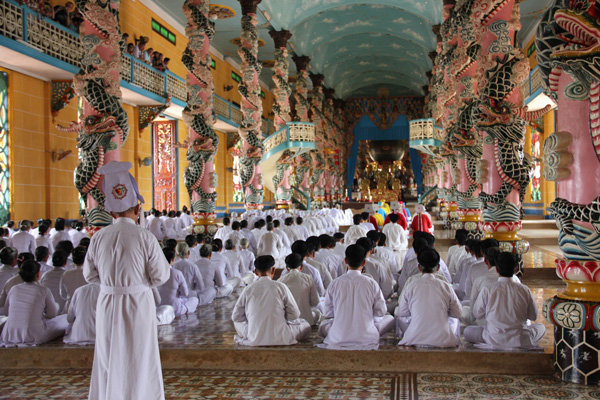
In 1949, an organization that campaigned for the unity of Caodaism, Converging Caodaism (Cao Dai Quy nhat), was established in the temporarily occupied area. It was headed by Nguyen Buu Tai. Although it was officially recognized by the contemporary authorities in 1951, it failed to extend its influence beyond the area of Sai Gon - Cho Lon. In 1952, it was renamed the United Caodaism (Cao Dai Thong nhat). In 1953, its activities started to become ebullient and involve some Caodaist sects such as Tien Thien Caodaism, Bach Y Caodaism, Chon Ly Caodaism, Caodaist Missionary Church and Chieu Minh Caodaism. A new management board was established and headed by Nguyen Phan Long. In 1956, it was renamed the Mobilizing Board for the Unity of Caodaism (Ban Van dong Thong nhat Cao Dai) and prepared a program for the unity of Caodaism. During this time, it was supported by Phan Khac Suu, who had become Member of Parliament of the Sai Gon authorities. The United Caodaism disintegrated in 1963. The Mobilizing Board for the Unity of Caodaism, which was directly under the United Caodaism and based in Cong Quynh Street, Sai Gon, still existed. It was later renamed the Board for Doctrinal Universalization (Ban Pho thong Giao ly). In 1968, the Sai Gon authorities officially recognized this organization under a new name, the Agency for Doctrinal Universalization (Co quan Pho thong Giao ly). It existed until the liberation of the South. On August 2, 2000, the Head of the Ho Chi Minh City Committee for Religious Affairs issued Decision No. 300/QD- BTG that officially recognized the legal status of this agency.

